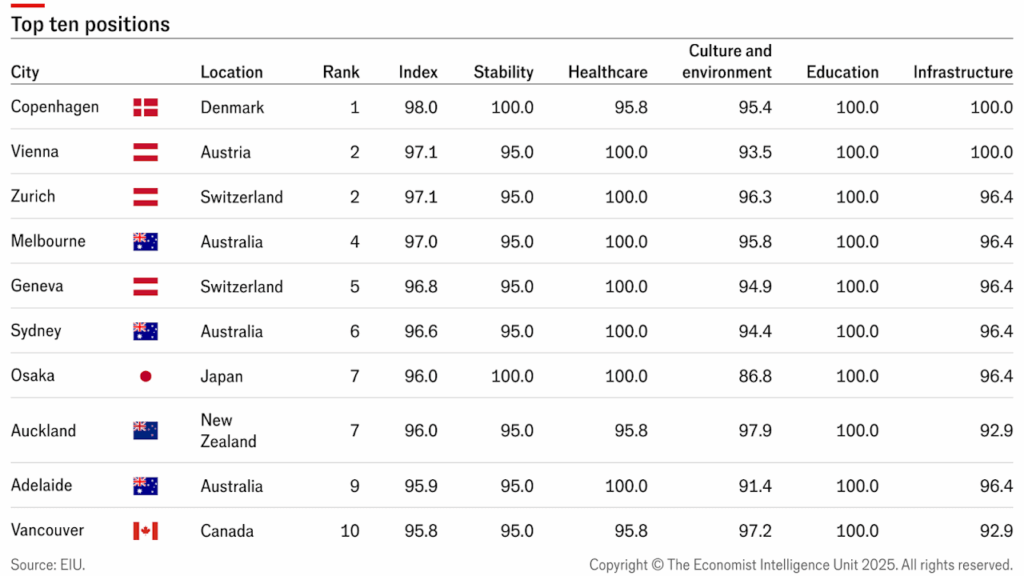Global Liveability Index 2025: Top Cities
Why in the News ?
- The Economist Intelligence Unit (EIU) has released its much-anticipated Global Liveability Index 2025, ranking 173 cities worldwide on the basis of their quality of life. The report provides insights into global urban trends post-pandemic, evaluates socio-economic resilience, and spotlights the widening disparity in liveability among developed and developing nations.
- Significantly, Copenhagen (Denmark) has emerged as the most liveable city in the world, scoring a near-perfect 98/100, while Damascus (Syria) continues to occupy the bottom spot.
- For India, Delhi and Mumbai are jointly placed at 141st, underlining persistent urban challenges such as inadequate public infrastructure, air pollution, and overburdened healthcare.

Background
The Global Liveability Index has become an authoritative benchmark for urban quality of life since its inception.
- Published annually by the Economist Intelligence Unit, the index serves a wide array of stakeholders, including corporations, policy planners, relocation agencies, and academics.
- It helps identify not just which cities are attractive to live in, but also highlights areas needing reform for urban administrators.
- In recent years, liveability has become a multidimensional issue, increasingly linked to climate resilience, inclusive infrastructure, mental health, and digital access. The COVID-19 pandemic catalysed a fundamental rethink in urban liveability parameters, placing greater emphasis on health systems and resilient governance.
- The 2025 edition of the Index builds on these evolving metrics to offer a comprehensive snapshot of the global urban landscape.
Key Features of the Global Liveability Index 2025
Publisher and Purpose
- Publisher: Economist Intelligence Unit (EIU), a sister organisation of The Economist magazine.
- Objective: To assess how comfortable it is to live in a given city, based on social stability, quality of services, and urban infrastructure.
Scope
- Covers 173 cities across continents, making it one of the most expansive global indices on urban quality of life.
- nges faced by residents in their day-to-day life.
Top Performers (2025)
- Copenhagen (98/100) – Scored perfectly in stability, education, and infrastructure.
- Tied 2nd: Vienna and Zurich – Maintained high ranks due to efficient public services.
- Others in Top 10: Melbourne, Geneva, Sydney, Osaka, Auckland, and Calgary.
- Western European and Asia-Pacific cities dominate due to universal healthcare, efficient transport systems, and clean environments.
India’s Performance
- Delhi and Mumbai are both placed at 141st out of 173.
- Persisting issues:
- Overstretched public healthcare
- Poor air quality and high pollution
- Traffic congestion
- Safety and sanitation concerns
- No Indian city figured in the top 100, indicating a need for systemic reforms.
Global
- Damascus (Syria): Conflict-ridden, with broken infrastructure and security threats.
- Tripoli (Libya) and Dhaka (Bangladesh) are plagued by civil unrest, poor healthcare, and environmental degradation.
Noteworthy Changes
- Al Khobar (Saudi Arabia) improved significantlyjumped 13 places due to healthcare and education reforms.
- Several cities in Eastern Europe and Latin America saw improvements due to political stabilisation and post-COVID recovery policies.
Challenges Highlighted by the 2025 Index
Urban-Rural and Global North-South Divide
- The index lays bare the liveability divide between developed and developing countries.
- While cities in Europe and Oceania thrive, South Asian, African, and conflict-ridden cities consistently score low.
- Resource inequality and governance gaps contribute significantly to this divergence.
Healthcare Crisis in Developing Cities
- Low scores in India, Bangladesh, and African countries reflect the fragile state of public healthcare.
- Overcrowding, low doctor-patient ratios, and limited emergency services remain persistent issues.
- The post-pandemic investment in healthcare is not yet yielding proportionate results in these regions.
Climate Change and Environmental Stress
- Many cities lost points under the Culture & Environment category due to:
- Extreme weather (e.g., heatwaves in Delhi, flooding in Jakarta)
- High air pollution levels
- Poor waste management systems
Infrastructural Deficiencies
- Urban sprawl, inadequate public transport, and poor road quality continue to plague cities like Mumbai and Delhi.
- Even in moderately performing cities, a lack of inclusivity for differently-abled persons and urban slums presents a grim picture.
Governance and Safety
- Cities in conflict zones like Damascus and Tripoli continue to suffer from low stability scores due to terrorism, political turmoil, and weak rule of law.
- In South Asia, women’s safety and law enforcement gaps drag down the liveability quotient.
Way Forward: Building More Liveable Indian Cities
Adopt a “Right to the City” Framework
- As proposed by UN-Habitat, India should formalise urban citizenship rights that ensure access to housing, healthcare, sanitation, and mobility for all residents.
- Make cities inclusive, safe, and accessible to marginalised groups, migrants, and the poor.
Strengthen Urban Health Missions
- Expand the Ayushman Bharat – Urban Health & Wellness Centres (HWCs) to deliver preventive and primary care in slums and peri-urban areas.
- Leverage telemedicine and mobile health vans in overcrowded metros.
Massive Investment in Clean Air and Transport
- Adopt successful models like Delhi’s Electric Bus Fleet, Mumbai’s Coastal Road Project, and Chennai’s Stormwater Drainage Network across Tier-1 and Tier-2 cities.
- Incentivise non-motorised transport and climate-resilient city planning.
Smart City 2.0 with a Human Face
While the Smart Cities Mission, initiated in 2015, was a step in the right direction, the second phase should:
Prioritise citizen-centric planning
- Use geospatial data for real-time governance
- Ensure infrastructure reaches the underserved neighbourhoods
Local Governance and Urban Decentralisation
- Empower municipal corporations with fiscal autonomy and professional staff (urban planners, sanitation engineers).
- Promote public participation through ward committees, digital grievance redressal, and social audits.
Education and Skill Infrastructure
- Build more public schools and skill centres in urban areas, especially near informal settlements.
- Integrate education with urban planning to make cities hubs of human capital development.
Gender-Responsive Urban Planning
- Install CCTV surveillance, well-lit streets, women-only transit options, and fast-track courts to address gendered urban insecurity.
- Launch more schemes like Delhi’s Mohalla Clinics and pink toilets for gender inclusivity.
Conclusion
The Global Liveability Index 2025 is a wake-up call for developing nations like India. As cities grow demographically and spatially, it is imperative to plan for people, not just populations. Improving urban liveability isn’t just about better roads or hospitals; it is about building dignity into daily life for all residents. With strategic investment, political will, and citizen participation, India can transform its megacities into truly liveable urban centres by the end of this decade.
Frequently Asked Questions (FAQs)
The Economist Intelligence Unit (EIU), the research arm of The Economist magazine.
It measures how liveable a city is for its residents, based on:
Stability (25%)
Healthcare (20%)
Culture & Environment (25%)
Education (10%)
Infrastructure (20%)
Cities are scored from 1 (intolerable) to 100 (ideal) based on 30+ indicators, both qualitative and quantitative.
Copenhagen (Denmark) ranked 1st with a score of 98/100, followed by Vienna, Zurich, and Melbourne.
MAINS PRACTICE QUESTION
Question: What does the Global Liveability Index 2025 reveal about urban disparities across the world, and how can Indian cities improve their liveability in line with global standards?
PRELIMS PRACTICE QUESTION
Q. About the Global Liveability Index 2025, consider the following statements:
- A city’s ranking can decline despite scoring high in education if its healthcare and stability indicators worsen significantly.
- Cities in regions affected by climate change-induced extreme weather events tend to lose points primarily under the “Stability” category.
- Despite geopolitical tensions in Europe, cities like Zurich and Vienna maintained top ranks due to their localised governance and resilience in infrastructure and healthcare.
- The Index explicitly includes metrics on digital access and internet connectivity under its Infrastructure sub-category.
How many of the above statements are correct?
✅ Correct Answer: C. Only three
Explanation:
- Statement 1: Correct. Healthcare and stability are weighted more heavily, impacting rankings even with good education scores.
- Statement 2: Incorrect. Climate-related impacts fall under Culture & Environment, not Stability.
- Statement 3: Correct. Zurich and Vienna remain top-ranked due to resilient systems.
- Statement 4: Correct. Digital access is factored into Infrastructure and Culture & Environment.







